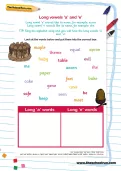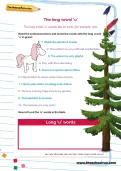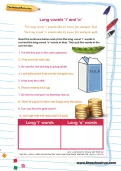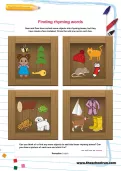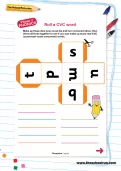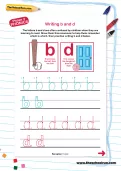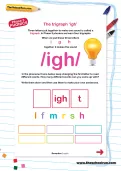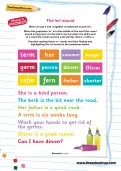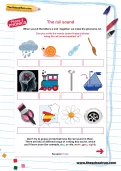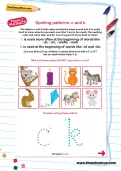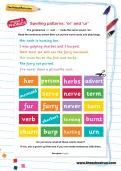A short vowel sound is pronounced for a shorter time than a long vowel sound. For instance, in the word fat, the vowel 'a' is short, but in fate, it's long. Use this worksheet to practise short vowel sounds and consolidate your child's phonics learning at home.
or
Register to add to your saved resources
A long vowel is pronounced for a longer time than a short vowel sound. In the word mat, the vowel 'a' is short, but in mate, it's long. Use this worksheet to practise the long vowel sounds 'a' and 'e' and consolidate your child's phonics learning at home.
or
Register to add to your saved resources
Long vowels are vowel sounds that are pronounced for a longer time than short vowels. In the word cut, the vowel 'i' is short, but in cute, it's long. Use this worksheet to practice the long vowel sounds 'u' and consolidate your child's phonics learning at home.
or
Register to add to your saved resources
Long vowels are vowel sounds that are pronounced for a longer time than short vowels. They can change the meaning of words. In the word bit, the vowel 'i' is short, but in bite, it's a long vowel sound. Use this worksheet to practice long vowel sounds 'i' and 'o' and consolidate your child's phonics learning at home.
or
Register to add to your saved resources
Help your child listen to sounds and identify rhyming words with this Reception activity sheet.
or
Register to add to your saved resources
Use our free phonics phases sound mats to see what sounds your child will be taught when in their phonics learning journey. These mats cover phonics phases 2-5.
or
Register to add to your saved resources
Using two consonant dice and a vowel die, play this simple phonics game with your Reception child and roll and write CVC words.
or
Register to add to your saved resources
A downloadable, printable Connect 4-style game to help children practise reading words with 'll' endings as part of Phase 2 phonics learning in Reception.
or
Register to add to your saved resources
Already a subscriber? to view this content.
Read these words with /ure/ sound then make up your own sentences using these ‘ure’ words.
or
Register to add to your saved resources
Already a subscriber? to view this content.
When we put two ee letters together we write the long vowel sound /ee/. Look at these pictures. How would you write these words? Now have a go at reading these sentences.
or
Register to add to your saved resources
Already a subscriber? to view this content.
The letters b and d are often confused by children when they are earning to read. Show them this mnemonic to help them remember which is which, then practise writing b and d. Then, using the phoneme frame, put the b at the beginning of the word and the d at the end. Keep changing the vowel to see what the new word says.
or
Register to add to your saved resources
Already a subscriber? to view this content.
Lots of words end in -ng or -er, making two-syllable words. Try adding these words to the endings -ing and -er to see how many new words you can make. Then cut out the jigsaw pieces and match together the first and second syllable to make a real word.
or
Register to add to your saved resources
Already a subscriber? to view this content.
In the phoneme frame below keep changing the first letter to read different words. How many different words can you come up with? Then answer these yes or no questions, then make up some of
your own using the ‘igh’ words.
or
Register to add to your saved resources
Already a subscriber? to view this content.
When we put the letters o and w together we get the sound /ow/ – it sounds just like the sound you might say if you hurt yourself! Read the sentences in the puzzle pieces and then draw a picture to go
with the sentence. Then cut each of the sentence and picture pieces apart and see if somebody can put them back together again.
or
Register to add to your saved resources
Already a subscriber? to view this content.
Practise reading these ‘er’ words and then finding and highlighting the /er/ sound in the sentences below.
or
Register to add to your saved resources
Already a subscriber? to view this content.
In the phoneme frame, keep changing the first letter to read different /ear/ words. How many different words can you come up with? Write them down and then use them to make up your own sentences then read the short sentences and fill in the missing word.
or
Register to add to your saved resources
Already a subscriber? to view this content.
In the phoneme frame below, keep changing the first letter to read different words. How many different words can you come up with? Write them down and then use them to make up your own sentences. Then have a game of pairs with these /air/, /igh/ and /ear/ sound words.
or
Register to add to your saved resources
Already a subscriber? to view this content.
When we put the letters a and i together we make the phoneme /ai/. Can you write the words under these pictures using the /ai/ sound spelled ‘ai’? Then cut out these words, read them and sort them
into piles of rhyming words.
or
Register to add to your saved resources
Already a subscriber? to view this content.
Which of these words DO NOT start with a c or k? Now cut out and put together these two dice. Roll both dice together and see if when you put the single letter in front of the ending if you get a real word or a silly word.
or
Register to add to your saved resources
Already a subscriber? to view this content.
The graphemes ‘er’ and ‘ur’ make the same sound, /er/. Read the sentences below then cut out the word cards and play bingo
or
Register to add to your saved resources
Already a subscriber? to view this content.

